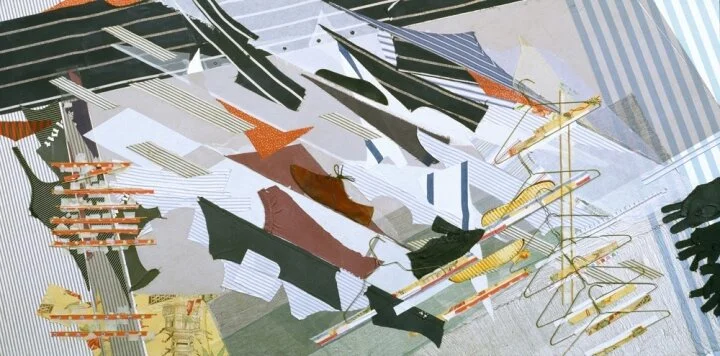Broken Collages Capture the Secret Lives of Things
Charles Platt’s exhibition encrypted messages at Freight+Volume gallery uses personal things to reconstruct a narrative, or at least parts of a story through which a life might be glimpsed.
Seph Rodney February 23, 2017
Charles Platt, “Blood, Bones, and Healing Devices” (2001), mixed media, 75 x 96 inches (all images courtesy the artist and copyright Charles Platt)
The fiction writer Harlan Ellison once wrote a description of an imaginary chair so well constructed to suit the human form that an alien race that had never seen a human in the flesh might be able to correctly construct a body using only the chair as a guide. It’s an intriguing idea for me: to see ourselves through the objects, to use them to construct or reconstruct a version of ourselves. We certainly do that historically. That’s what time capsules are for. They are caches of select objects that are supposed to be so intimately bound up in what a group of people does that they become identifiable through these objects, so that another group might formulate an account of how they lived and were meaningful to each other and themselves. But to communicate our sundry and diverse abilities, desires, and stories, you have to have more than a chair. To convey our complex experiences, you might need a lot of things.
Charles Platt, “Cityscape” (2010), mixed media, 48 x 72 inches
Charles Platt’s new solo exhibition, encrypted messages at Freight+Volume gallery uses personal things to reconstruct a narrative, or at least parts of a story through which a life might be glimpsed. He collages broken vinyl records, leather wallets, paper shooting targets, trousers, dresses, jackets, shoes, wire hangers, US money, sunglasses, gloves, wood, metal mouse traps, and the cardboard packaging of baby powder. These objects are all cut open and splayed, fixed to a substrate as if pressed between two layers of transparent glass, as if inviting the viewer to examine them in detail, like sandwiching a drop of blood in a specimen slide to see what is really going on below the surface.
Charles Platt, “Re-union” (2000), mixed media, 48 x 96 inches
Charles Platt, “Going Nowhere” (2003), mixed media, 48 x 96 inches
The work isn’t precisely nostalgic, though it has touches of warm, crinkly feelings, like the piece, “Blood, Bones and Healing Devices” (2001), in which the story of a car accident is told bit by bit through torn clothing stained with blood (his own shirt, the gallery attendant tells me), a walking cane, parts of a medical brace, car keys, broken eyeglasses, and other pieces of shattered glass. The composition moves from the left edge to the right like a concussive wave had passed through an idyllic scene and tossed everything into the air and let it smash down without a care.
The front of the exhibition contains mostly static compositions, the clothing and objects lain down as if arranged for a snapshot. But Platt gets exciting when he places these personal items in such relation to each other that a story is strongly implied. He surprises me more with “Re-union” (2000), where the objects become abstract from a distance of a few feet; the abstraction moves my eyes in and out of the work’s depths, like being pulled on a leash. Similarly, in “Going Nowehere” (2003), which reminds even more than “Re-union” of the Italian futurists, diagonal compositions surge forward, sending the shoes and clothes hangers up and out of the work, sailing on the parcels of fabric caught in a wind I cannot feel, but nevertheless see the evidence of.
Installation view of encrypted messages at Freight + Volume gallery
Platt has his own backstory that makes for a curious read. He was for many years a successful architect, but kept making these collages, which he began in 1959. According to the gallery’s press, he left oil painting after returning to his studio to find a pair of overalls hanging on his work. He realized that the most quotidian objects when placed in proximal relationships had resonance in a way he could explore for decades. Many of the works do read as post-war, American, modernist explorations, but they also read as tiny stories with unresolved endings.






